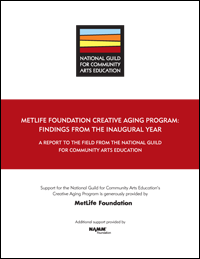MetLife Foundation Creative Aging Program: Findings From the Inaugural Year
A Report to the Field From the National Guild for Community Arts Education
Download:
![]() MetLife Foundation Creative Aging Program: Findings From the Inaugural Year (252kb)
MetLife Foundation Creative Aging Program: Findings From the Inaugural Year (252kb)
In 2008, the National Guild for Community Arts Education (then the National Guild of Community Schools of the Arts) received funding from the MetLife Foundation to pilot the Creative Aging Program. The program provided indepth technical assistance and seed grants of $5,000 to $7,500 to nine National Guild member organizations for the design, implementation, and evaluation of sustainable, 12-week creative aging programs: participatory, skillbased arts education programs intended to improve quality of life for adults age 60 and above.
The goals of the pilot program were to
- increase the capacity of National Guild members to serve older adults;
- provide models of high-quality creative aging programs to the field; and
- raise public awareness about the benefits of creative aging programs.
Results
Evaluation results revealed a likely correlation between participation in the Creative Aging Program and participants’ improved mood. This fi nding is consistent with those of more controlled research in the field of creative aging (such as the National Endowment for the Arts’ 2005 Creativity and Aging study).
This report describes other results of the program evaluation:
- Physical health benefits—While most participants rated themselves as being in good health, more than 60 percent attributed any improvement in health to the program.
- Mental health benefits—Before the program, just over 67 percent of participants reported rarely or never feeling lonely over the past four weeks. After the program, the percentage increased to 77.5 percent, and 52 percent attributed the decrease in loneliness to the program.
- Increased social activity—Before the program, 31 percent said that they participated in social activities eight or more times a week. After the program, the percentage increased to 42 percent, with just over 51 percent of those participants indicating that the increase was due to the program.
- Sense of accomplishment—When asked about what they accomplished during the program, 80 percent of participants identifi ed an arts-related goal. Seventy-nine percent felt that the teaching artists significantly met their needs—the top rating—and 67.5 percent agreed that the teaching artists made them feel that they could make decisions or choices about learning or creating art for themselves.
- Satisfaction with the program—Almost 97 percent of the participants felt that the environment met their learning and creating needs. More than 84 percent said that they would recommend the program to a friend or family member, and more than 78 percent rated the program as “excellent.”
- Mutual interest in creative aging programming—Grantee organizations and older adults participants expressed an interest in continued involvement with the arts and one another.
Lessons Learned, Challenges, and Advice
The 2008 grantees described the following essential ingredients in designing and carrying out an effective creative aging program:
- Commitment to collaboration, partnership, and teamwork
- Willingness to listen to participants
- Having a teaching artist who enjoys older adults
- Appreciation for the value of social engagement for older adults
- Realistic awareness of what can be completed (setting benchmarks and goals) within the time constraints
- Using and implementing an assessment process
- Planning for sustainability from the beginning of the program
The main challenges for many grantees were participant retention, irregular attendance, and the concomitant need to help participants catch up with what they had missed.
When asked to share advice that might help other organizations that wish to develop a creative aging program, the grantees commented:
- Create a program that has a structured curriculum, but flexible enough to allow for individual approaches and experimentation.
- Focus on the wants and needs of older adults.
- Have seniors engage in meaningful arts activities.
- Understand that introducing change may take time, especially once a routine is established.
- Become familiar with Creativity Matters: The Arts and Aging Toolkit.
- Ensure that your teaching artists are professional.
- Partner with another organization or agency (such as a senior center) that has expertise in working with older adults.
- Ensure that each team member knows his or her role and that all are equally committed to the established goals and timeline.
- Build social time into the curriculum.
- Try to incorporate intergenerational experiences.
- Just do it!

